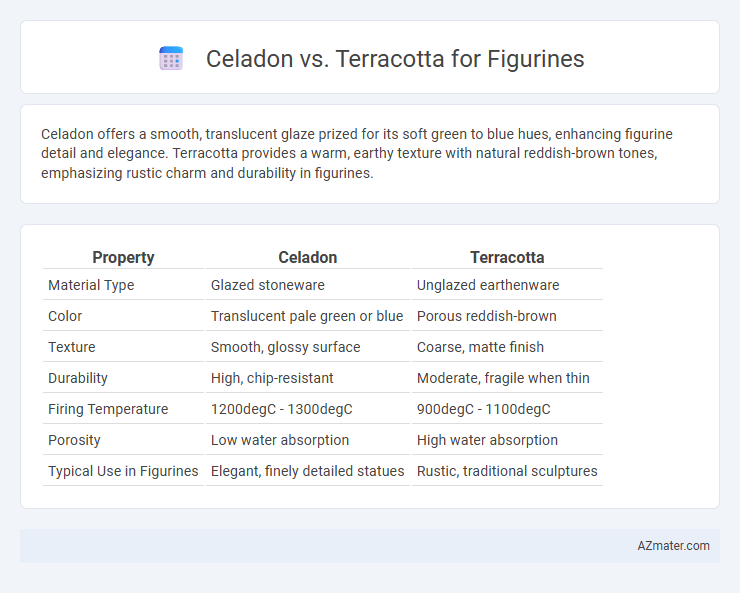Celadon offers a smooth, translucent glaze prized for its soft green to blue hues, enhancing figurine detail and elegance. Terracotta provides a warm, earthy texture with natural reddish-brown tones, emphasizing rustic charm and durability in figurines.
Table of Comparison
| Property | Celadon | Terracotta |
|---|---|---|
| Material Type | Glazed stoneware | Unglazed earthenware |
| Color | Translucent pale green or blue | Porous reddish-brown |
| Texture | Smooth, glossy surface | Coarse, matte finish |
| Durability | High, chip-resistant | Moderate, fragile when thin |
| Firing Temperature | 1200degC - 1300degC | 900degC - 1100degC |
| Porosity | Low water absorption | High water absorption |
| Typical Use in Figurines | Elegant, finely detailed statues | Rustic, traditional sculptures |
Introduction: Celadon vs Terracotta Figurines
Celadon figurines, crafted from glazed porcelain with a signature jade-green finish, highlight intricate details and a smooth, glass-like surface offering durability and elegance. In contrast, terracotta figurines are made from unglazed, porous clay with a warm, earthy tone that emphasizes rustic charm and handcrafted authenticity. The choice between celadon and terracotta depends on desired aesthetics, cultural significance, and the preservation environment of the figurine.
Historical Significance of Celadon and Terracotta
Celadon glazing originated in ancient China during the Eastern Han Dynasty, valued for its jade-like translucence and cultural symbolism of purity and elegance. Terracotta, dating back to prehistoric times, gained historical prominence as the material for the iconic Terracotta Army of the Qin Dynasty, symbolizing protection and power in the afterlife. Both materials reflect distinct cultural heritages: celadon highlights refined artistry and aristocratic tastes, while terracotta embodies monumental and spiritual significance in ancient civilizations.
Material Composition and Source
Celadon figurines are crafted from high-quality porcelain clay, characterized by a smooth, glass-like texture and a signature translucent green glaze derived from iron oxide in a reduction firing process. Terracotta figurines consist of porous, reddish-brown earthenware clay fired at lower temperatures, typically sourced from natural, mineral-rich clay deposits found in regions such as the Mediterranean and South Asia. The distinct material compositions influence durability, surface finish, and artistic detail, with celadon offering a refined, glossy look, while terracotta provides a rustic, earthy aesthetic.
Crafting Techniques Compared
Celadon figurines are crafted using a specialized high-temperature glaze technique that creates a smooth, translucent, jade-like finish, emphasizing precise kiln temperature control and iron oxide content for its signature greenish hue. Terracotta figurines, by contrast, are made from porous, unglazed earthenware clay shaped and fired at lower temperatures, highlighting more rustic, textured surfaces and traditional hand-molding methods. The key difference lies in celadon's intricate glazing process versus terracotta's simplicity focused on natural clay properties and firing techniques.
Visual Aesthetics: Color, Texture, and Finish
Celadon figurines feature a translucent glaze with soft green to blue hues that emphasize smooth texture and subtle depth, creating an elegant and refined finish. Terracotta figurines showcase warm, earthy tones ranging from reddish-brown to ochre, with a matte or slightly rough surface that highlights natural clay texture and artisanal craftsmanship. The choice between celadon and terracotta impacts the visual appeal significantly, with celadon offering a polished, luminous appearance while terracotta provides a rustic and organic aesthetic.
Durability and Longevity
Celadon figurines are glazed with a smooth, glass-like surface that enhances their durability by providing a protective barrier against moisture and wear, making them less prone to chipping and cracking over time. Terracotta figurines, crafted from porous earthenware clay, are more susceptible to damage from water exposure and physical impact, which can reduce their longevity without proper sealing. The glazed finish of celadon not only improves resistance to environmental factors but also preserves the intricate details and color depth, ensuring a longer lifespan compared to the more fragile terracotta material.
Cultural and Regional Associations
Celadon glazed figurines are deeply rooted in East Asian cultures, especially within China, Korea, and Japan, where the delicate green-blue hues symbolize elegance, purity, and harmony. Terracotta figurines hold significant cultural importance in Indian and Mediterranean regions, often reflecting themes of fertility, protection, and ancestral worship through their earthy tones and robust forms. Both materials serve as cultural artifacts that convey regional artistic traditions, spiritual beliefs, and historical narratives unique to their origins.
Use Cases: Decorative, Religious, and Functional
Celadon figurines are prized for their smooth, jade-like glaze, making them ideal for decorative displays and symbolizing serenity in religious settings, particularly in East Asian cultures. Terracotta figurines, with their earthy texture and durability, are commonly used in functional roles such as garden ornaments or ritual objects in both ancient and contemporary religious practices. Both materials offer distinct aesthetic and cultural values, with celadon favored for refined indoor decor and terracotta suited to rustic, outdoor, or ceremonial purposes.
Maintenance and Preservation Tips
Celadon figurines require gentle cleaning with a soft, damp cloth to preserve their delicate glazed surface, avoiding harsh chemicals that can damage the subtle jade-green finish. Terracotta figurines need careful dusting and should be kept in low-humidity environments to prevent cracking or erosion of the porous ceramic material. Both types of figurines benefit from stable temperature conditions and protection from direct sunlight to maintain their structural integrity and vibrant appearance over time.
Choosing the Best Material for Your Figurine
Selecting the best material for your figurine depends on the desired aesthetic and durability; celadon glaze offers a smooth, translucent finish with subtle green or blue hues that highlight intricate details, making it ideal for elegant, decorative pieces. Terracotta provides a warm, earthy texture with natural reddish-brown tones and is valued for its rustic charm and robust, porous nature, suitable for more traditional or artisanal figurines. Consider celadon for refined, delicate appearances and terracotta for organic, tactile qualities when choosing the perfect material for your figurine.

Infographic: Celadon vs Terracotta for Figurine
 azmater.com
azmater.com